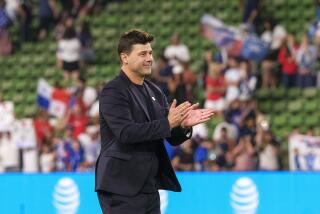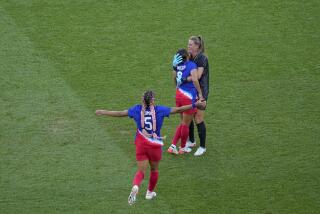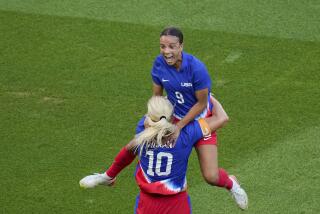U.S. World Cup win draws record TV ratings; team looks at what’s next

The U.S. women’s national soccer team arrives at Los Angeles International Airport following their 5-2 victory over Japan on Sunday in the Women’s World Cup final.
- Share via
Reporting from VANCOUVER, Canada — Fourteen hours after its one-sided win in the final of the Women’s World Cup, the U.S. team gathered Monday near Vancouver’s bay-side convention center for another in a seemingly endless procession of public victory celebrations.
On the edge of the crowd a small woman pushed forward, holding out a bag of candy. “Make sure they get it,” said Aya Miyama, captain of the Japanese team.
Even the vanquished came to pay tribute to the victors, so complete was the Americans’ 5-2 triumph over the defending champions Sunday.
“It’s been unbelievable,” said Carli Lloyd, whose hat trick in the first 16 minutes of the final also strained credulity.
Her three goals were more than any team had scored in the previous six Women’s World Cup finals. And it also made the U.S. the first team to win three championships.
But those weren’t the only records broken Sunday.
The game drew 26.7 million viewers to Fox and Telemundo, the largest U.S. television audience for a soccer game. (The 2014 men’s World Cup final was watched by 26.5 million people on ABC and the Spanish-language Univision network.)
The average audience for Sunday’s Cup final was also better than every game in the recently-concluded NBA Finals as well as the 2014 Sochi Olympic Winter Games.
In 90 minutes, Lloyd went from a player often overlooked on her own team to one of the most famous athletes in the U.S.
“It’s definitely gone to another level,” Lloyd said. “I’m not sure I’m ready for that.”
She’ll get a few months to find out. The World Cup championship team will gather at L.A. Live at 11 a.m. Tuesday for its first public celebration in the U.S. before beginning a 10-game victory tour next month that is expected to stop in Southern California during the fall.
That will leave Jill Ellis and her coaching staff little time to prepare for the U.S. team’s next big test, the 2016 Olympic Games in Rio de Janeiro. And there’s a lot of work to be done between now and then.
“There will be transition after this World Cup,” Ellis said. “Moving forward younger players will start to break through even more.”
That’s by necessity more than choice. The U.S. had the oldest team in the World Cup with 10 players age 30 or older. Three of them — Christie Rampone, Abby Wambach and Shannon Boxx — may stick around for next summer’s Olympics but no further.
Others have decisions to make. Goalkeeper Hope Solo will be closing in on her 38th birthday when the next World Cup kicks off. And Lloyd, who promised to be back, by then will be weeks short of her 37th birthday.
“A lot of them have a lot to think about and mull over,” Ellis said. “And that’s something we’ll get to a bit further down the line.”
Regardless of how those decisions turn out, the core of Ellis’ team going forward is likely to be built around a handful of young players who distinguished themselves in this tournament.
Defenders Meghan Klingenberg, 26, and Julie Johnston, 23, entered 2014 with fewer than two dozen starts for the U.S. national team between them. But injuries forced Ellis to pair them with Ali Krieger and Becky Sauerbrunn on a makeshift back line. And since that quartet started its first game together in March, the U.S. has gone 11-0-2 and allowed just four goals, with Johnston making the short list for the World Cup’s top player award.
Morgan Brian, the youngest player on the team at 22, started the last three World Cup games at a new position, holding midfielder, and responded brilliantly, freeing Lloyd up to join the attack. Lloyd scored five of her six World Cup goals with Brian playing behind; three of those goals put the U.S. ahead to stay.
Then there’s the injury-plagued Alex Morgan, 26, who erased any question about her toughness. Hampered by a knee injury early in the tournament, she started the final five games on artificial turf, sparking what had been a moribund offense.
“They have shown very clearly they belong,” Ellis said. “They’ve had big moments in big games, and the future is very bright.”
It’s about to get brighter with the addition of the versatile Crystal Dunn, 23. A defender with the national team, Dunn was one of the last players cut before this World Cup. But she has become an attacker with the Washington Spirit, leading the National Women’s Soccer League with seven goals in 11 games.
“It’s definitely looking at the landscape,” Ellis said of the process she’s facing. “Looking at what we need. Conversations with players, knowing what holes you’re going to have to fill.
“But I do feel like this World Cup has given us an investment in the future. Fifty percent of this team is new and they’re young and they’re still hungry.
“And they’ve had this amazing experience to help fuel them.”







